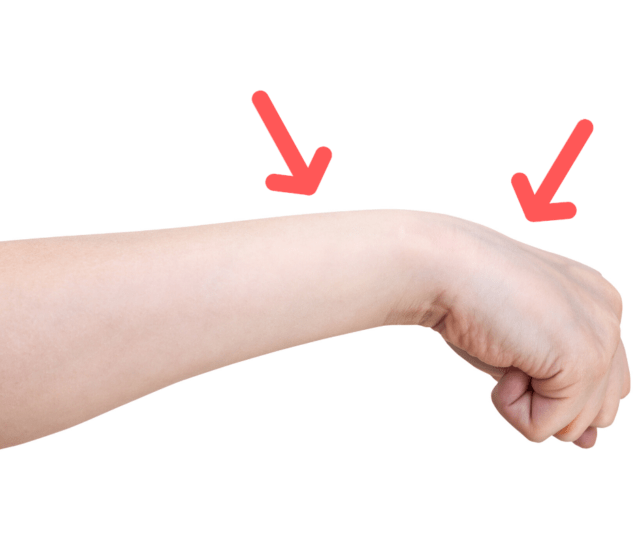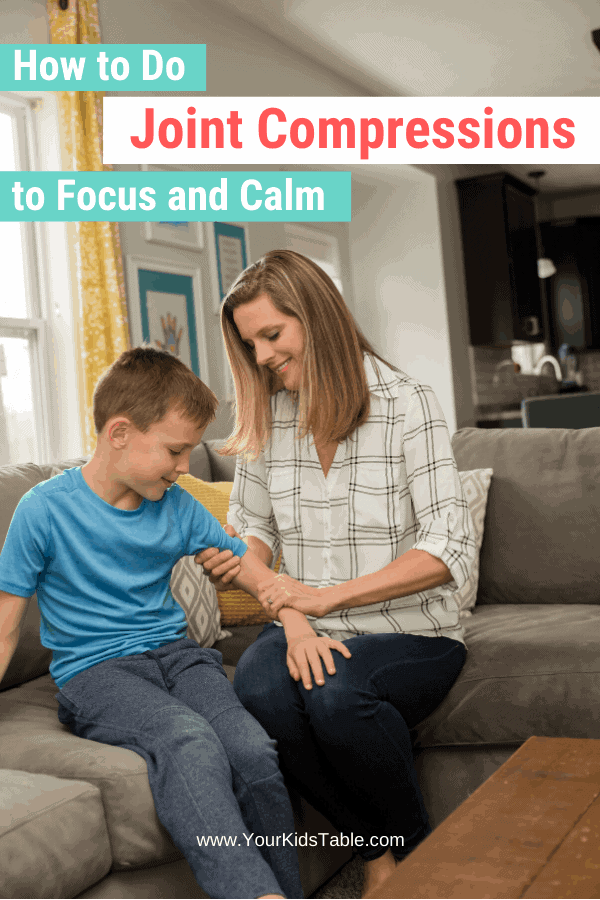Joint compressions are a free and powerful sensory tool to use to help kids calm down and follow directions! Learn how to do them the right way and when you shouldn’t use them as a sensory activity…
It’s definitely not common knowledge.
It even sounds a little weird.
Yet, this special sensory tool doesn’t cost a penny and when it’s done right, almost seems like magic. It’s definitely one of my go-to strategies as an occupational therapist.
Since, it’s so easy – and free – once you know how to do it, you might even find yourself using joint compressions in unusual circumstances.
You may have heard the powerful example I shared of using joint compressions while I was teaching Sunday School. A little boy was bouncing off the walls and ignoring all directions to come with the rest of the class. He was totally disconnected and not focusing at all.
I found a quiet moment with him and used joint compressions. Immediately afterwards, he joined the rest of the class with excellent attention. Read the whole story and the power of proprioception.
What Are Joint Compressions?
Joint Compressions are a sensory processing activity that stimulates proprioceptive receptors in the joints by squeezing, or compressing the joints repeatedly for a few seconds at a time. While you can get the effects of joint compressions by squeezing behind furniture or pushing up against a wall, it typically isn’t quite that targeted.
It’s most beneficial when an adult can give these joint compressions to a child.
Why Do Joint Compressions Work?
Joint compressions are effective because our sense of proprioception has loads of receptors located in our joints and muscles that we can’t see.
It’s something we completely take for granted. But, those receptors throughout are body are constantly sending signals to our brain about where our body is so that we can walk around without bumping into things constantly. That gives us our sense of body awareness, otherwise known as our 6th sense: Proprioception.
Some kids, particularly, sensory seekers who love movement and rough play, often aren’t getting enough proprioceptive input.
So, they seek more.
Joint compression is a targeted way to give them the sensations they crave. Once that need is met, they’re free to focus on the other demands in their environment, like learning, following directions, or playing with peers.
Do Joint Compressions Help Every Child Calm and Focus?
Just like any other sensory activity joint compressions aren’t a one size fits all sort of situation. Joint compressions help a lot of kids calm and focus, but not all kids. Some may actually seem uncomfortable during the use of joint compressions or not like the sensation at all.
This tends to happen with kids that have a tactile sensitivity, meaning they don’t like touching different textures. Sometimes that means that the deep pressure touch they experience is dysregulating their sensory system instead of regulating it.
If a child is generally more sensitive to sensory input, then they may not respond or not like it. Sensory sensitive kiddos tend not to struggle with wild behaviors, but can get overwhelmed. In that case, if a child with sensitivities responds to joint compressions, they can be helpful in calming them down.
What sensory activities a child will respond well to does vary quite a bit, so it’s always a good idea to try many times before giving up on an activity.
Getting Permission for Joint Compressions…
Since joint compressions are a passive activity for your child, meaning you’ll be doing it to them, you want to make sure you get permission from them that it’s okay to do it to them.
How you get this permission will depend on the child and their age.
For younger or more adventurous children, you can simply say something like, “Hey, I want to try something. It’s kind of a like a hug on your arms and legs.”
Or, as I said with the little boy in Sunday School, “Let’s try to shake (or squeeze) the silly’s out!” As I did this, especially since he didn’t know me that well, I made sure we were in a quiet corner of the room without a lot of other kids around, then I squatted down to eye level and cautiously approached touching his wrists.
As I started to shake, I was watching his reaction like a hawk. If he had shown me even the slightest sign that he was uncomfortable, I would’ve stopped.
If your child is more cautious and you could potentially catch them off guard by approaching them, then you may want to try it at a time when they’re calm first. In this case, I would say something like, “Hey, I learned this new trick that could make your body feel good/help you calm down for bed/help you finish your homework. It’s pretty cool. I’m going to show it to you.”
You can ask them if they’d like to try, but when kids are given the option to say no, they often will just to be contrary. That’s why I avoid asking them if they want to.
Never, Ever Do This When You Use Joint Compressions!
If your child whimpers, pulls away, or seems not to like the joint compressions at any point, then stop.
Immediately.
Forcing kids to participate in any sensory activity can be tempting, especially if you’ve heard it can help them, but as soon as it’s forced, it’s no longer helpful. In fact, it can damage their sensory processing, pushing them to become more wary and protective.
Remember that your child may experience sensations very differently than you.
You may love digging your feet in the sand, but to your child, the same sand on their toes could feel like razor blades.
How to Do Joint Compressions
I’m going to walk you through the steps for joint compressions. They can be done with kids of any age and when completed for all the limbs, you’ll be finished in 2-3 minutes. But, you don’t have to complete the whole series. In public settings, often when they’re the most needed, I’ll usually just use compressions on the arms or shoulders.
Step 1: Take both of your hands and cup them around either side of your child’s wrist. Then squeeze firmly and push your hands together towards the joint and then back out.

Step 2: Repeat this back and forth quickly while maintaining the firm pressure for up to 20 times. I usually do 10 squeezes and count quickly (see the video below).

Step 3: Move to other joints, repeating the same repetitions of squeezing. It works most fluidly if you can move to the next closest joint. Since we started at the wrist, although you can choose any starting point, I would continue to the elbow, then the shoulders. Other joints to use joint compressions are the hip, knee, and ankle.

Watch the Video Demo of Joint Compressions
Here’s a full, but quick demo of joint compressions being used on a child:
Tips for Using Joint Compressions
- If your child likes joint compressions, they can be used quickly in a store or classroom by coming up behind them and just pushing down on their shoulders, as if you were trying to plant them into the ground.
- Joint compressions can be used throughout the day as many times as your child needs or requests.
- If you use sensory diet cards, like these, include joint compressions as an option on one of the cards.
- Counting or singing a short song as you complete the joint compressions can help kids pay attention to the activity without trying to leave because their attention is pulling them in another direction.
Learn When to Use Joint Compressions + Other Sensory Activities
Joint compressions can be a helpful tool to have in your bag of tricks when your child is getting overwhelmed, not listening, or running wild. But, there’s a lot of other simple sensory activities that can help too. The key is to know what sensory activities will help your child!
That way your child gets their sensory needs met, which means they can overcome the sensory challenges that usually get in their way. Things like poor attention, difficulty sleeping, communicating with peers, and learning!
To learn 3 expert secrets to calm and focus your child with sensory activities, grab a seat in my free workshop. We’ll send you a free workbook to bring to the workshop when you sign up too!
Click here to grab a seat now!
More on Joint Compressions
Real Help for Kids Sensitive to Noises with 5 Easy Steps!
Genius Hacks to Survive the Holidays with Sensory Kids
Powerful Proprioceptive Activities that Calm, Focus, &; Alert
Alisha Grogan is a licensed occupational therapist and founder of Your Kid’s Table. She has over 15 years experience with expertise in sensory processing and feeding development in babies, toddlers, and children. Alisha also has 3 boys of her own at home. Learn more about her here.

good explanation but the joints should always be straight, not bent before doing joint compressions.
Hi!
You mention in the text that we shouldn’t do it if the child finds it uncomfortable – does tickling count? Your boy in the video seems to think that it tickles:-)
Hey Camilla,
Thanks for reaching out! Each child responds to feeling ticklish differently, for some that feeling can feel almost painful and in that case it would be best to take a break. The boy in the video is Alisha’s son and mostly just getting silly! She does pause and give him mini breaks throughout the video when she feels like he’s getting a little ticklish, so that is an option too. I hope that helps!
Best,
Andrea
Hi Alisha,
I am an Early interventionist working with toddlers who are often sensory seeking and have difficulty with self-regulation. I was wondering what your thoughts are on using a single joint compression held for a count of 10 (about 8 seconds) vs. the “pumping” 5-10 joint compressions usually used for calming? Is there any data comparing the two or any negatives of using a single compression style?
Thank You!
I have the same question – neurologically in terms of muscle contraction – deep/ slow tends to be calming/inhibitory versus quick /fast tends to be facilitory – at least at the muscular level. In terms of sensory regulation, especially if I have a sensory child with high tone, I feel like I should be doing slow/prolonged compressions instead of quick/fast ones – the faster ones would make sense to use with a hypotonic child. I have a long history of phys/dys with adults and only a few years in EI with babies, so my “upbringing” as an OT is more of a neuromuscular approach verses sensory integration – if that makes sense. I am thinking maybe ANY joint compressions release neurotransmitters that affect the sensory system the same way throughout (overall calming) versus at the muscular level, there is a different effect which may excite or inhibit the muscle, but not so much the whole sensory system???
Yes, any joint compression will provide the release. You can try out going slower on children who need it in a sensory sense but making sure there is enough pressure/force for the actual compression.
Best,
Desiree
Hi Alisha. I work with adults with eating disorders, many who tend to be “busy” (i.e. active people) who sometimes use physical activity to compensate for their agitation and/or intake. I’m wondering if there is much evidence for the use of joint compression in adults in general and/or with people with EDs? Any help, suggestions or advice is welcomed 🙂
Hey Mark,
Joint compressions are naturally calming for everyone. I’d go ahead and try it with your adults as it may help some of them!
Best,
Desiree
Reading this late in the game: as someone who is recovered, I found joint compressions to be incredibly helpful! And craniosacral massage. However I know MANY ed folks who have body dysmorphia or sexual abuse who would NOT be ok with receiving touch. I’d say it’s a toss-up, but I’d recommend a professional massage therapist to clients—touching clients without proper licensure is a big no-no.
HI Mark! I know this is many years after your post but I found myself on this page wondering the EXACT same thing. Also curious about the implications of body awareness in terms of body dysmorphia. Not sure if you’ll see this reply but if you do, I’d love to connect and chat!